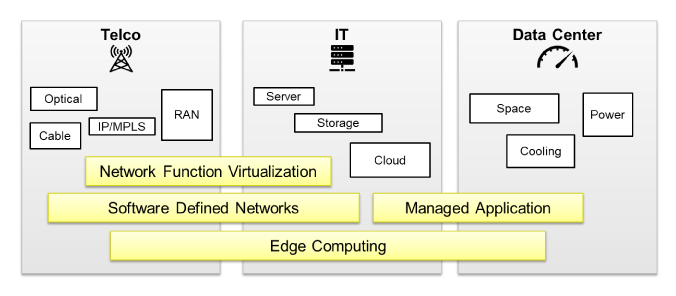Keeping Pace with 5G
Simplicity, promised by softwarization, urges providers to maintain high-availability clouds and data centers. As a result, new network operation teams, or NetOps, must consist of individuals with a broad knowledge of networks and IT. And, of course, there is a diversity of VNF vendors with proprietary EMS, which again create silos in the cloud.

Figure 1 - the challenge of managing hybrid resources across domains
Hybrid resource management enables NetOps to crush complexity and gain transparency on the hybrid network.
The Solution
Put simply, utilizing a network resource inventory (NRI) system is proven to drive operational efficiency. To master hybrid resource management, ICT service providers must adopt a solution known as unified resource inventory (URI), or hybrid inventory (HI), to document all resources in one place, across the silos.
Selecting the right hybrid inventory solution is key to helping CTOs and network operators keep track of available resources, improve time to market for new services, prevent misconfiguration, reduce recovery time from network outages, and significantly lower overall OPEX. The ideal hybrid inventory solution should provide the following features and capabilities:
- All-embracing data model and resource types: passive, physical, logical and virtualized
- Modern REST API to integrate with its environment, e.g. Trouble Ticketing and Fault Management systems
- Discovery and reconciliation mechanisms to synchronize the inventory with network and cloud to keep it up-to-date
- Support for service fulfillment and assurance scenarios
Another important component to a hybrid inventory solution is a common central database for all resource-related data. This database ensures that all activities carried out within the organization are always based on a shared master data source, and that all NetOps maintain the same consistent view of the network at all times.
The successful operation of 5G Cloud RAN, for example, requires that the following resources are documented and available immediately in a hybrid inventory solution:
- Physical resources: Antennas, RRUs and other 5G physical equipment on mobile sites
- DC Infrastructure: Edge data center floorplans, racks, power and cooling devices
- Logical Telco resources: Fronthaul and backhaul transmission links
- Logical IT resources: Server clusters, platforms, and storage
- Virtual resources: Clouds, virtual machines, containers, vBBU, and MEC applications
- Resource-facing services: Network slices for IoT and AR
To ensure that service assurance runs smoothly, every type of resource listed above must be documented in relation to its context and with its capacity descriptors. These



















